WARHOLSTARS JANUARY - MAY 1964
1928 - 1959 - 1960 -1962 - 1963 - Jan - May 1964 - June-December 1964 - 1965 - 1966 - 1967 - 1968 -1969 - 1970 - 1974 - 1975 - 1979 - 1980s+
JANUARY 1964: AN OVAL PORTRAIT ILLUSTRATION BY ANDY WARHOL APPEARS IN HARPER'S BAZAAR.
Warhol's cameo-like oval portrait illustration for "The Great Soap Revival" in the January 1964 issue of Harper's bears a similiarity to the round Jackie tondos which the cat. rais. attributes to "probably February or March" 1964 - although presumably the Harper's image was completed during the last months of 1963, depending on the copy deadline at the time.
The illustration was one of the last that Warhol did for Harper's during the '60s. Warhol had begun doing work for the magazine in 1951. In 1979 the magazine would also commission him for a two page spread of perfume bottles. (HB5)
JANUARY 17, 1964: ANDY WARHOL SHOOTS FOOTAGE FOR THE THIRTEEN MOST BEAUTIFUL BOYS - SCREEN TESTS.
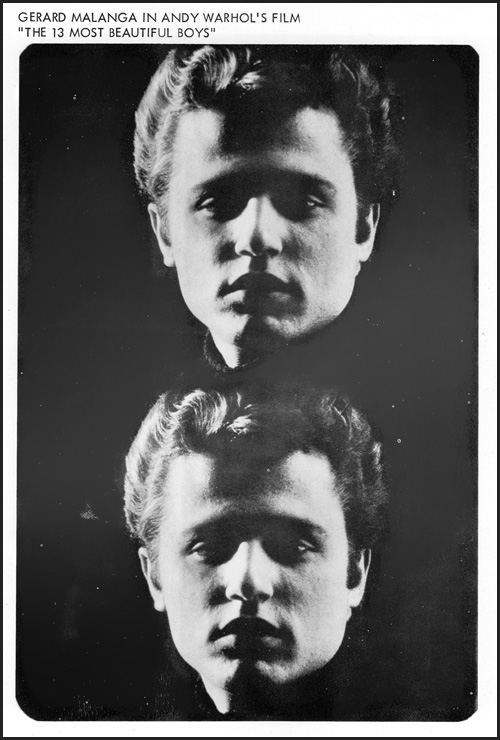
Film Culture magazine, No. 33, Summer 1964
The Thirteen Most Beautiful Boys was a compilation of some of Andy Warhol's Screen Tests (in various configurations) which were filmed 1964-1966. The Screen Tests shot or selected for The Thirteen Most Beautiful Boys were those of: Gerard Malanga, Kelly Edey, someone identified as "Boy," Bruce Rudow, Denis Deegan, Sophronus Mundy, John Giorno, Freddy Herko, DeVerne Bookwalter (star of Blow Job), Tony Towle, Rufus Collins, Billy Linich (Billy Name), Kenneth King, Walter Dainwood, Peter Hujar, Paul Thek, Gregory Battcock, John Palmer, Dennis Hopper, Taylor Mead, Robert Pincus-Witten, David Hallacy, Howard Kraushar, Richard Markowitz, Steve Stone, Helmut, Lawrence Casey, Steve Balkin, Walter Burn, Joe LeSueur, someone identified as "Star of the Bed," Larry Latreille, Francois de Menil, James Claire and Roderick Clayton. (AD246-9)
From Andy Warhol Screen Tests: The Films of Andy Warhol Catalogue Raisonné, Volume One by Callie Angell:
"The very first Screen Tests were shot for the film series The Thirteen Most Beautiful Boys, a work that was inspired by a a 1962 New York City Police Department pamphlet entitled The Thirteen Most Wanted. The pamphlet was also the source of the photographic images that Warhol used in his controversial 1964 mural, Thirteen Most Wanted Men, which was briefly installed on the exterior wall of Philip Johnson's New York State Pavilion at the New York World's Fair in April... Interestingly, the first Screen Tests made for The Thirteen Most Beautiful Boys seem to have been shot before Warhol started work on the Thirteen Most Wanted Men mural. The earliest documented mention of these films is found in Kelly Edey's diary entry for January 17, 1964, in which he noted: 'This afternoon Andy Warhol made a movie here, a series of portraits of a number of beautiful boys, including Harold Talbott and Denis Deegan and also me.' Warhol, who was facing an April 15 deadline for completion of his [Most Wanted Men] mural, seems not to have begun work on the Thirteen Most Wanted Men until February, which suggests that the began the film series while his commissioned mural was still in the planning stages... The last Screen Tests marked for The Thirteen Most Beautiful Boys are those of James Claire and Roderick Clayton, which were shot on 1965 stock probably in 1966, when both Claire and Clayton appeared in Warhol's film Hedy....
Interestingly, there seems to have been few if any public screenings of The Thirteen Most Beautiful Boys outside of the private venue of Warhol's Factory. Unlike The Thirteen Most Beautiful Women, the Most Beautiful Boys was never offered for rental through the Film-Makers' Cooperative catalogue, and no distribution records of it being shown have been found. The only references to a public showing of The Thirteen Most Beautiful Boys mention a screening at the New Yorker Theater on December 7, 1964, when Film Culture magazine presented its Sixth Independent Film Award to Warhol. Various Warhol films were announced in the flyer, including 'excerpts from The Thirteen Most Beautiful Women;' although unannounced, Freddie Herko's Screen Test from The Thirteen Most Beautiful Boys was also shown, according to descriptions by both James Stoller and David Bourdon." (AD244-245)
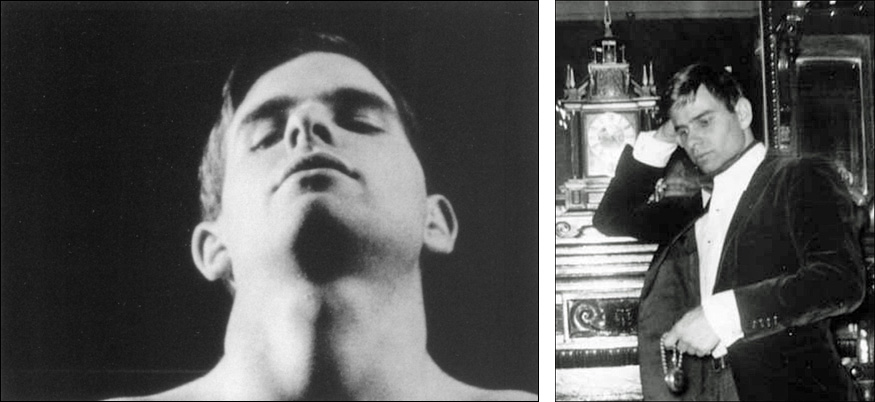
Left: One of the two Screen Tests shot of Kelly Edey by Andy Warhol in 1964, Right: Kelly Edey c. 1970 (Photographer unknown) (Collection of Theodore Dell)
Winthrop Kellogg Edey (Kelly Edey) noted in his diary entry for January 17, 1964, that "This afternoon Andy Warhol made a movie here, a series of portraits of a number of beautiful boys, including Harold Talbott and Denis Deegan and also me." (AD13) Edey came from a wealthy New York family and was known for his collection of clocks which he willed to the Frick museum. Part of his collection is still on public display there. (GBA)
The "13" in the title of The Thirteen Most Beautiful Boys was most likely borrowed from a New York City Police brochure of "The Thirteen Most Wanted" which was also the inspiration for Warhol's mural Thirteen Most Wanted Men at the 1964 World's Fair in Queens. (AD13)
These film portraits were some of the earliest examples of Warhol's Screen Test series. It is interesting to note that they were filmed in Edey's apartment prior to Warhol's move to his silver Factory where most, but not all, of the other Screen Tests were made. Although Gerard Malanga has maintained that the Screen Test series started as a result of him asking Warhol to shoot a headshot of Gerard to use to publicize Malanga's poetry readings, a more likely inspiration for the Screen Tests was the photobooth photography that Warhol started doing in the late spring of 1963. (AD13)
Sometimes Warhol's photobooth photographs would be the basis of a silkscreened portrait. From approximately 1970, when Warhol bought a Polaroid Big Shot camera (AWP157), he would use Polaroid photographs to get an image for his commissioned portraits, but during the sixties he used a photobooth. When Holly Soloman posed for her photobooth pictures in 1966, which were used to create her silkscreen portrait, she recalled that the time spent in the booth was "pretty boring" so she "started to really act in them." (AWP94). The end result was that the photobooth pictures, taken with a still camera, were often more animated than the Screen Tests, taken with a movie camera, where subjects were told to remain as still as possible. In both instances, Warhol removed himself from the process - a type of "automatic" photography/filmmaking reminiscent of the Dada concept of "automatic" writing or painting.
JANUARY 28, 1964: ANDY WARHOL STARTS THE FACTORY. (GMW127)
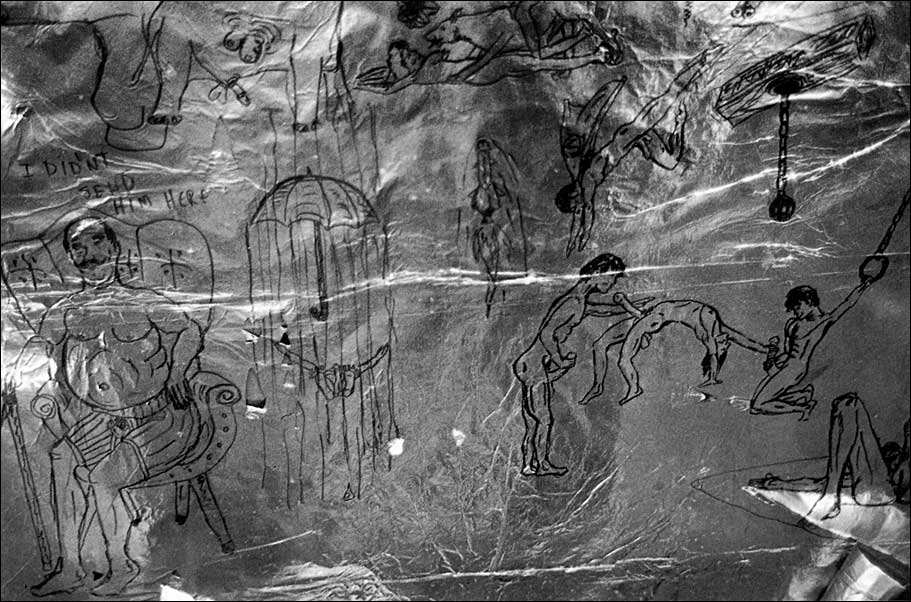
Binghampton Birdy's "mural" on the foiled wall of the toilet at the Factory (c. 1965 - 67) (Photo: Stephen Shore)
The first Factory was located on the fifth floor of 231 East 47th Street - across the street from the YMCA and below an antiques place called Connoisseur’s Corner. According to one account given by Gerard Malanga, the first works of art created at the Factory were "a series of food boxes." (POP61/LD188/GMW34)
Gerard Malanga:
"Andy would arrive at the Factory, as it was now called, noon or thereabouts. We would work on and off until about 5:00 or 6:00 pm and then go out to party... The first works created at the Factory were a series of food boxes. Andy was fascinated by the shelves of foodstuffs in supermarkets and the repetitive, machine-like effect they created... He wanted to duplicate the effect but soon discovered that the cardboard surface was not feasible. I located a carpenter in the East Sixties, and Andy hired him out to build plywood boxes that we would then paint and screen, to create the illusion of the real thing... The brand names chosen consisted of two versions of Brillo, Heinz Tomato Ketchup, Kellogg's Corn Flakes, and Mott's Apple Sauce. We obtained cardboard-box samples of each of these products wither from a grocery store or, in the case of the Brillo box, directly from the manufacturer. I'd deliver the cardboard box, at this point flattened out, to the silkscreen manufacturer Harry Golden, who made all of Andy's screens... We were able to get at least two sides done in a day. A hundred or more were produced in a period of a month. They were literally three-dimensional photographs of the actual products..." (GMW34)
Although they didn't move into the Factory until January 28, 1964, Malanga recalls going to the company who made the boxes in December 1963:
Gerard Malanga:
"On a cold, blistery day in early December, 1963, I found my way to a stepdown storefront at 409 East 70th Street between First & York Avenues. The Havlicek Woodworking Company, Inc... Mr. Havlicek... a burley guy in his midforties... took my order and gave me a smile: 'Several hundred boxes please!' Boxes cut from pine and cut to size, fitted together with tiny wood nails. 17 x 17 x 14 inches, to be exact was one such size, I recall...
A few days after the move to our workspace, January 28th, a truckload of wood boxes arrive, individually wrapped and taped in clear plastic sheeting. And so would begin the arduous task of taping the floor with rolls of brown paper and setting out each box in a gridlike pattern of eight rows lengthwise... Billy Name and I would take turns painting with Liquitex all six sides of each box - which numbered nearly 80 - the Campbell's tomato juice for starters, by turning each box around on its side. We waited until the paint dried. Andy and I repeated this process silkscreening all five sides again down the line. The sixth side - the bottom side - remained blank... Completing the work took nearly six weeks, from early February well into mid-April." (GMW47-8)
1964: ANDY WARHOL'S WORK SCHEDULE IN 1964 ACCORDING TO POPISM.
According to Popism, “We usually worked till around midnight, and then we’d go down to the Village, to places like the Cafe Figaro, the Hip Bagel, the Kettle of Fish, the Gaslight, the Cafe Bizarre, or the Cino. I’d get home around four in the morning, make a few phone calls, usually talk to HENRY GELDZAHLER for an hour or so, and then when it started to get light I’d take a Seconal, sleep for a couple of hours and be back at the Factory by early afternoon.” (POP73)
1964: BILLY NAME MOVES TO THE FACTORY.
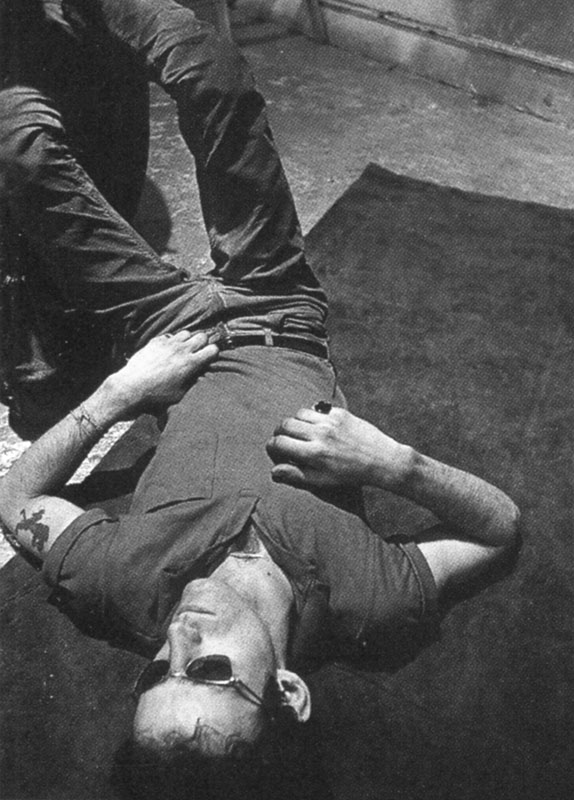
Billy Name relaxes at the Factory (1965) (Photo: David McCabe)
Billy Name and Andy Warhol's relationship changed from "awkward attempts to be lovers to being conspirators in the fine arts" (B). Billy moved into the Factory and created the "silver look" as an "installation for Andy to have a fabulous place to work in." (B)
Billy was inspired to paint the Factory silver by the seven year repainting of the Mid-Hudson-Bridge which was near his family home in Poughkeepsie, New York. The paint used for the bridge was aluminium industrial paint - the same that Billy later used for the Factory. (BN28)
JANUARY 1964: MEMBERS OF JUDSON DANCE THEATER, INCLUDING ROBERT RAUSCHENBERG, PERFORM AT THE STATE UNIVERSITY OF NEW YORK.
Judson Dance Theater members who participated included LUCINDA CHILDS and ROBERT RAUSCHENBERG. Rauschenberg's dance piece, Shotput, was one of the new dances on the program which was titled "Concert for New Paltz (Performed by Seven of Judson Dance Theater)." (JD186)
The program notes for the evening noted the link between contemporary visual art and dance: "In the curious way in which the art world changes, painters have made inroads into theatrical performances. Artists find that there are no unacceptable sources for material. The repertoire of Judson Dance Theater reflects the latest of this recent tendency to allow freer play. Dancers, mixed with painters on the stage, point out how there is another quality to bodies than just the arrived at differences dancers have discovered in themselves - there is the whole look of the body, which knows a lot on its own, and whether 'trained' or not, relays much of its history with action." (JD187)
In February and March, the same participants (plus Robert Morris and Albert Reid) presented two different programs on a four-week series at Stage 73 located at 321 East 73rd Street, calling themselves the Surplus Dance Theater. (JD187) The Judson Dance Theater members who were part of the Surplus group (including LUCINDA CHILDS and ROBERT RAUSCHENBERG) also appeared in the Once Festival in Ann Arbor, Michigan on February 27, 1964, with their performances billed on the flyer as "The Cream of the Crop - from the Judson Dance Theater." (JD193)
JAN/FEB 1964: ANDY WARHOL HAS HIS FIRST EUROPEAN SHOW.
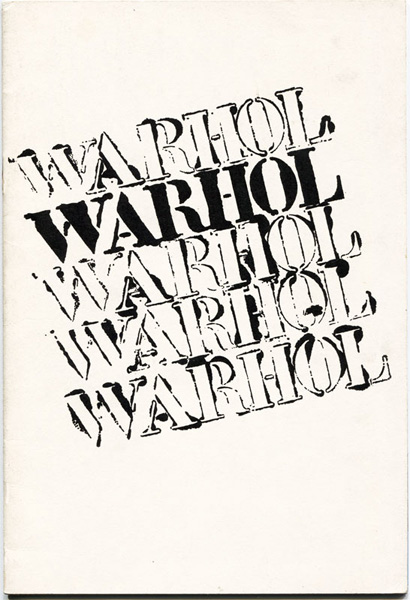
Exhibition catalogue for "Warhol" at Galerie I. Sonnabend, Paris, France, January-February 1964. 10 pages with text (in French) by Jean-Jacques Lebel,Alain Jouffroy and John Ashbery. A folded reproduction of the Blue Electric Chair was included as part of the catalogue.(JDC)
Although Bob Colacello wrote in Holy Terror: Andy Warhol Close-Up that "In 1964 Andy had his first European show - the Flower Paintings at the Paris gallery of Ileana Sonnabend,"(BC28) the exhibition actually consisted of Warhol's "Death and Disaster" paintings, including Bellevue I, Green Disaster, Orange Car Crash, Blue Electric Chair, Mrs. McCarthy and Mrs. Brown (Tunafish Disaster), Pink Race Riot, Green Car Crash and White Burning Car Twice. (Colacello was confusing Warhol's second show at Sonnabend's Gallery with his first at the gallery. The second show, which did consist of Flowers, took place the following year, opening in May 1965.) (RN473)
Ileana Sonnabend was the ex-wife of New York art dealer Leo Castelli. They had divorced in 1959. (ISS) It's interesting to note that Warhol had a solo show at Sonnabend's gallery more than six months prior to signing with her ex-husband and about eleven months before his first solo show at her ex-husband's gallery. Ileana had been getting consignments from Warhol since 1962. The first consignment was dated October 7, 1962 and consisted of twelve pieces: six paintings and six drawings. The paintings were Campbell's Soup Can (Tomato), Big Torn Campbell's Soup Can (Black Bean), Green Coca-Cola Bottles, Marilyn in Black and White, Twenty Marilyns and Four Marilyns.Three of the paintings were exhibited in a group show called "Pop Art Américain," at Sonnabend's Gallery in May 1963 which also included work by Lee Bontecou, John Chamberlain, Claes Oldenburg, James Rosenquist and Tom Wesselmann. The Warhol paintings shown in that exhibition were Big Torn Campbell's Soup Can (Black Bean), Marilyn in Black and White and Twenty Marilyns. (RN473)
EARLY 1964: ANDY WARHOL DOES SECOND SELF-PORTRAIT SERIES.
From the Andy Warhol Catalogue Raisonné (Vol 2A):
"In a film by Bruce Torbet, Loner at the Ball, Warhol used this series to demonstrate the two principal aspects of his technique: screen printing and painting by hand...The early 1964 date of this Self-Portrait follows closely on Warhol's first series of Self-Portraits that were probably made in December - January... Although they are close in date, it seems clear that the two series should be classified distinctly. Technically and stylistically, the earlier group depends on the example of the Scull portrait of mid-1963, whereas the second series looks ahead to the single exposure portraits and increasingly improvisatory approach to local colour characteristic of Warhol's work during the mid-1960s." (RNA240)
c. FEBRUARY - LATE NOVEMBER 1964: ANDY WARHOL PAINTS JACKIE ONASSIS.
The Andy Warhol Catalogue Raisonné indicates a starting point or "terminus a quo" for Warhol's Jackie paintings by citing "an invoice from the silkscreen maker dated February 4, 1964" which "establishes not only a terminus a quo for this series but its chronological immediacy to the events on which it is based." (RNA103)
For an ending point or "terminus" for the series, the cat. rais. cites a Newsweek article about the Multiplied Jackies and also notes a December consignment (and installation) of Jackies at the Leo Castelli gallery: "An account of its [Multiplied Jackies] being painted, reported in the December 7, 1964 issue of Newsweek, establishes the date of this work in late November. In early December, forty-nine canvases of the same type and background were consigned to Castelli Gallery in three groups of fourteen canvases each... That month, while Warhol's exhibition of Flower paintings was on view at Castelli, forty-two of the forty-nine Jackie canvases were hung together as a single painting, filling a wall in the back gallery." (RNA142)
The cat. rais. also draws an analogy between the Jackies and Warhol's portrait of Ethel Scull: "The parallel between the Jackie series and the portrait of Ethel Scull is especially to the point. In fact, the Scull portrait, which dates from mid-1963, established a technical prototype for the production of the later series. As with Ethel Scull, eight images of Jackie were assembled onto a mechanical for the silkscreen maker... For the Scull portrait, three distinct mechanicals were made. Warhol pasted two photobooth strips, each with four exposures, side by side on the mechanical... The same format was used for the eight Jackie details that he selected... His handwritten notations for the screen maker, 'Please make like in line very black and white,' scarcely differ from those on the Scull mechanical, 'Make contrast like before. B & W.' Both were to be enlarged to 80 inches..." although the cat. rais. also notes that "unlike the Scull portrait and related photobooth portraits, with their multihued grounds, the Jackie canvases vary little in colour..." (RNA103-4)
FEBRUARY 2 - FEBRUARY 29, 1964: ANDY WARHOL EXHIBITS HIS BOX SCULPTURES AT THE DWAN GALLERY IN LOS ANGELES.
Andy Warhol first exhibited his box sculptures in a group show called "Boxes" at the Dwan Gallery in Los Angeles. The exhibition catalogue was also a box:
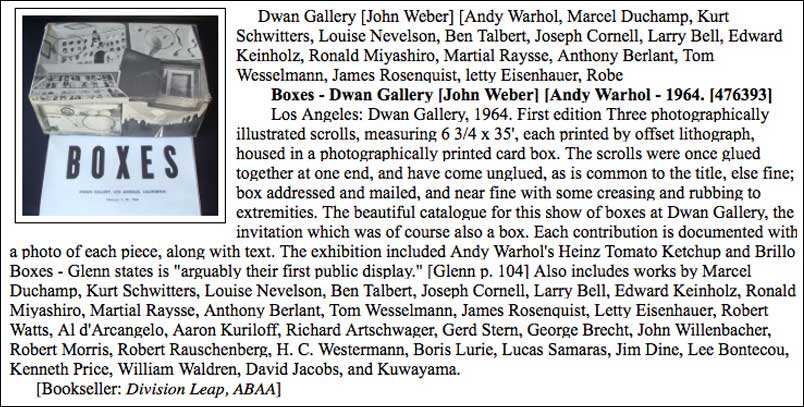
Division Leap's listing for the Dwan Gallery exhibition catalogue box via vialibri
See: Andy Warhol's Box Sculptures at the Dwan Gallery.
FEBRUARY 2, 1964: ANDY WARHOL FILMS EAT.
The film consisted of Robert Indiana eating a mushroom. Indiana was one of the artists commissioned to do a work for the New York State Pavilion at the 1964 World's Fair which Indiana also titled Eat. According to Grace Glueck in the New York Times, Indiana's illuminated mural was "said to have remained unlighted since shortly after the fair opened." (RNA026) Warhol was also commissioned to do a work for the Pavilion. He produced his Most Wanted Men mural for the project although it was covered up with silver paint by the time the fair opened. (See "April 22, 1964: World's Fair opens with Warhol's Most Wanted Men mural painted silver" below.)
FEBRUARY 5, 1964: GERARD MALANGA POETRY READING AT LE METRO ANNOUNCED IN THE SINKING BEAR. (ATF)
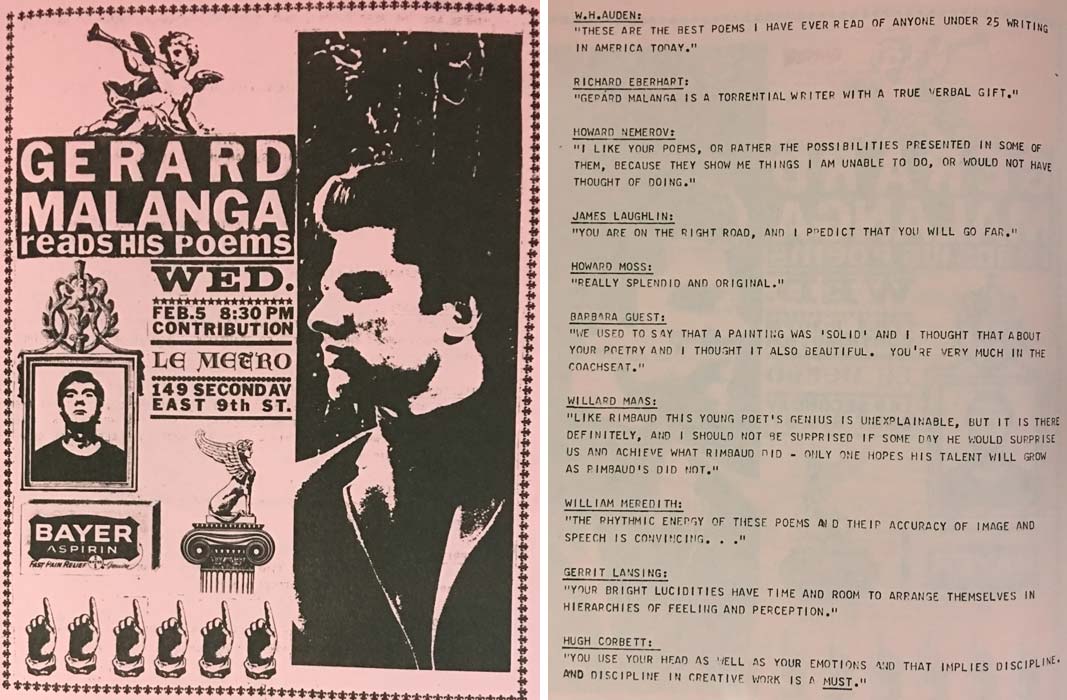
Left: A full page announcement that appeared in the November 1964 issue (No. 6) of The Sinking Bear, ed. by Soren Angenoux in collaboration with Ray Johnson, Billy Linich (Billy Name) and "editorial consultants" Yvonne Rainer, Michael Smith and "Carlos Clarens (hora de concoura)" - Right: Quotes on the back of the page
c. FEBRUARY 1964: JOHN VACCARO AND FREDDY HERKO PERFORM AT THE NEW YORK POETS THEATRE.
John Vaccaro would later direct theatrical versions of RONALD TAVEL'S Shower and The Life of Juanita Castro at the Coda Gallery for two weekends beginning July 29, 1965 and at the St. Marks Playhouse in September 1965. Other notable experimental productions directed by Vaccaro included Conquest of the Universe at the Bouwerie Lane Theatre in November 1967 (with a cast that included Ultra Violet, Ondine, Taylor Mead and Mary Woronov) and two productions of Cockstrong at La Mama in June 1969 and March 1970. He also directed Son of Cockstrong in February 1970 at La Mama.
From Playing Underground: A Critical History of the 1960s Off-Off-Broadway Movement by Stephen J. Bottoms:
"[Alan] Marlowe found the venue for their [the New York Poets Theatre] first production - the 'Off-Bowery Theatre' on East Tenth Street... The company performed two triple bills there, opening in October and December 1961, but subsequently abandoned this obscure, unappealing space. In 1962, they took out a two month lease at the Maidman Theatre on Forty-fourth Street, and mounted a series of happenings, film screenings, and music and poetry recitals, but no plays. It was not until February 1964 that the group - whose members were constantly engaged in a variety of individual projects - organized themselves sufficiently to coordinate their next production. Now performing under a new name, the American Theater for Poets, the group presented a new triple bill at the 'New Bowery Theatre' at 4 St. Mark's Place... After just two months, however, the company was evicted by the police, for reasons that remained unclear even to them.
... When not setting out to shock, the group's emphasis was often on a kind of neodadaist formalism. The February 1964 bill, for example, included di Prima's Murder Cake, a text composed by chance techniques using the I-Ching, and Love's Labor by Frank O'Hara... Di Prima describes Murder Cake as a 'word score' rather than a play 'for a director to do with as s/he wills.' JAMES WARING, who directed it, seems to have been particularly adept at this approach. As a choreographer, he was celebrated for his creation of 'exquisitely lyric' visual forms through the collage-like assembly of abstract movement and everyday materials: dance critic Jill Johnston once described his work as 'a happening' with dance as the protagonist...
John Vaccaro, who acted with the company at this time, found Waring's work inspirational because it helped him realize that a director is free to take all kinds of creative license with such open-ended textual material... Vaccaro seems also to have taken direct inspiration... from Alan Marlowe's production of Love's Labor, which turned the piece into a kind of outrageous, transvestite farce (much to the disgust of Waring, who had staged an earlier version of the piece for the Monday Night Series in 1960). With a wild, campy cast including Vaccaro, FRED HERKO, and the drag queen and freak-show artist FRANKIE FRANCINE, the production was, di Prima remembers, 'a great demonstration of harmony in chaos... there were moments when twenty or more people were cavorting separately on that little stage.'" (SB62-64)
FEBRUARY 17, 18, 19, 1964: FREDDY HERKO PERFORMS IN FANTASTIC GARDENS AT THE JUDSON CHURCH.
Elaine Summers' mixed-media evening, Fantastic Gardens, was performed in the sanctuary of the church and included film projections (including a split screen projection), dancers, music, sculpture and audience participation. Photography was credited to Elaine Summers, Stan Vanderbeck, Carol Summers, Eugene Friedman, Ka Kwong Hui and Billy Linich (aka BILLY NAME). (JD190) Dancers included FRED HERKO and BIBBE HANSEN'S father, the Fluxus artist Al Hansen. (JD189) A film collage included a recurring image of Herko wearing an overcoat and watering a garbage can until he eventually lifts the cover to find sprouting flowers. (After Herko's suicide in October 1964, Warhol would dedicate one of his Flowers paintings to the dancer.)
Elaine Summers:
"Fantastic Gardens was the first full-evening intermedia concert in New York City combining film, dance, music, and sculpture. The concert was presented in three parts with two intermissions. The first section consisted of a film collage of dances, using chance methods inspired by John Cage. In the second section, 'All Around the Hall,' members of the audience were seated around the edge of the Judson Memorial Church in the form of a pyramid. Film images were splashed over the ceiling, floor, walls and audience... In the third section, 'Other People's Gardens,' one of the sculptures, a large metallic 'tree' built of junk, became the instrument played by composer Malcolm Goldstein. Several films were show successively. One of these, a film of Sally Stackhouse dancing, was projected onto a split screen..." (JD189)
Jonas Mekas, in his review of the show in the Village Voice noted that the evening was not the first multimedia experiment - giving as examples the work of Roberts Blossom, Stan Vanderbeek and Robert Whitman - but wrote that Fantastic Gardens was "by far the most successful and most ambitious attempt to use the many possible combinations of film and live action to create an aesthetic experience." (JD190)
FEBRUARY 23, 1964: FREDDY HERKO'S BIRTHDAY.
FORMAL BIRTHDAY POEM: February 23, 1964
by Diane di Primadear Freddie, it's your birthday & you are crazy
really gone now, crazy like any other old queen
showing off your naked limbs a little withered
making fairy tales into not very good balletsI remember you sat on the edge of the bed & Joan cried
you sat wrapped in a blanket night after night by the fire
you sat by the fire & cried, you played the piano
you were truly lovely then, but a little fathow spoiled we all were! we ate hundreds of english muffins
and never thought once about white flour, or bread lines
or calories, or what vitamins we were getting
I guess old junkies just have to be more carefulyes, now you are 28, you are shooting A
you are getting evicted & there is another coldwave
you are worried about your costumes - can you take them
with you & to where? you are late a lot for performanceand not very good, although you are sure you are perfect.
yes, somebody said you thought you were martha graham
and it is a little like that. but blood is thicker
than water, & I am angrywhen I am angry, because you've disgraced the family
another old whore on the streets, another mouth
to feed in emergencies, and we think a lot
about keeping you away from jail & the madhouse
EARLY 1964: ANDY WARHOL FILMS BLOW JOB.
The first public screening of BLOW JOB took place at Ruth Kligman's Washington Square Gallery in March 1964.
1964: LOU REED WRITES I'M WAITING FOR THE MAN AND HEROIN. (LR71)
Reed wrote both songs while still a senior at college.
1964: NICO SINGS.
Nico auditioned as a singer at the Blue Angel in New York. She got the job even though she fainted after the audition. (UT33)
MARCH 1964: ANDY WARHOL GETS RAIDED.
Warhol's three minute film, ANDY WARHOL FILMS JACK SMITH FILMING NORMAL LOVE was screened in New York with Genet's Un Chant d'Amour. The screening was raided by New York police and both films were confiscated. The Warhol film was never returned and apparently "disappeared for good". (DB175)
The raid was covered by the Village Voice although they didn't mention Warhol's film:

Village Voice, March 19, 1964, p. 13
MARCH - APRIL 1964: THE POCKET THEATRE PRESENTS "EVENTS AND ENTERTAINMENTS" WITH FRED HERKO, JAMES WARING, YVONNE RAINER, DEBORAH HAY AND BEVERLY SCHMIDT.
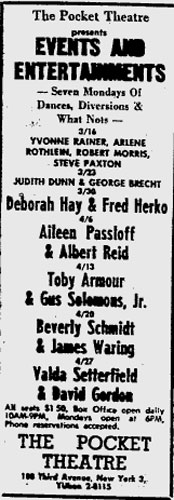
Village Voice ad, 12 March 1964
MARCH/MAY 1964: HOME MOVIES AT THE JUDSON CHURCH.
Home Movies was a play by Rosalyn Drexler presented by the Judson Poets' Theater at the Judson Memorial Church. In addition to Freddy Herko playing a raging queen named Peter Peterouter, the cast also included Judson minister Al Carmines as a randy priest, Father Shenanagan. (SB157)
From Playing Underground: A Critical History of the 1960s Off-Off-Broadway Movement by Stephen J. Bottoms:
"The roles in the play [Home Movies] thus became inextricable from the people playing them, and Drexler made various textual adjustments in response to material the performers developed in rehearsal. 'Watch me metamorph into a mannered and pompous queen,' Peter Peterouter declares at one point in the script, and the following stage directions describe him 'pranc[ing] around making grotesque faces at the audience,' while stripping off his outer clothes to reveal a rhinestone necklace and knee-length red dress... Sadly, Herko did not appear again at Judson: he committed suicide later that year by dancing out of the second floor window of Johnny Dodd's Cornelia Street apartment." (SB157-8)
There are two productions of Home Movies on the Judson Memorial Church production list - one with a first performance on March 20, 1964 and one with a first performance listed as May 22, 1964. It is unknown whether Herko participated in both productions as the production list does not include cast members. The production list notes that "Productions were generally (but not always) presented over three consecutive weekends." Rosalyn Drexler received an Obie Award for Distinguished Plays for Home Movies and Al Carmines an Obie for Best Music for both Home Movies and What Happened.
APR. 21 - MAY 9, 1964: ANDY WARHOL HAS HIS SECOND SOLO POP SHOW IN NEW YORK AT THE STABLE GALLERY.
Andy Warhol's second show at the Stable Gallery consisted of his product box sculptures - some of which had been exhibited previously at the Dwan Gallery in Los Angeles (see above). Vol. 02A of the cat. rais. notes that "the exhibition consisted of several hundred individual boxes, including examples of each type" including Kellogg's Cornflakes, Mott's Apple Juice, Del Monte Peach Halves, Campbell's Tomato Juice, Heinz Tomato Ketchup and Brillo and Brillo (3c Off) boxes. (p. 055)
A poster headed "Personality of the Artist" is often reproduced as a poster for the exhibition, but according to art writer William S. Wilson, the poster was advertising a series of lectures by Gene Swenson. See: "Gene Swenson, Andy Warhol and the Personality of the Artist."
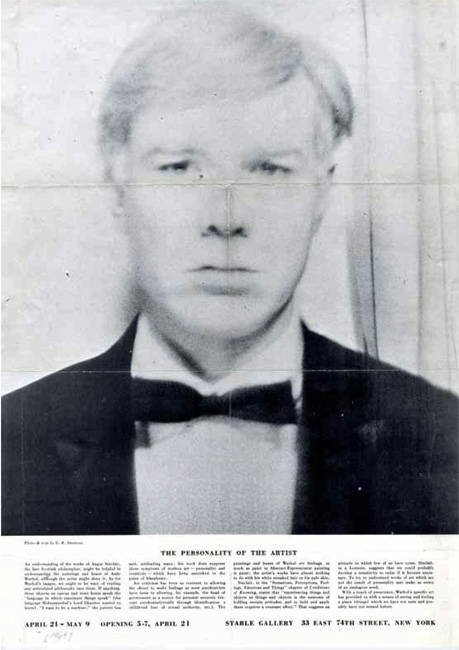
"Personality of the Artist" poster with photograph and text by Gene Swenson
According to Gerard Malanga, the exhibition at Eleanor Ward's Stable Gallery was titled The Personality of The Artist. (GMW148) The exhibition would be Warhol's last show at the Stable. In late September he signed with LEO CASTELLI. (BC28) The night after the opening, Robert and ETHEL SCULL hosted a part in Warhol's honour at the Factory. (GMW148) Gerard Malanga recalls both himself and Bill Name helping Warhol with the sculptures:
Gerard Malanga:
"On a cold, blistery day in early December, 1963, I found my way to a stepdown storefront at 409 East 70th Street between First & York Avenues. The Havlicek Woodworking Company, Inc... Mr. Havlicek... a burley guy in his midforties... took my order and gave me a smile: 'Several hundred boxes please!' Boxes cut from pine and cut to size, fitted together with tiny wood nails. 17 x 17 x 14 inches, to be exact was one such size, I recall...
A few days after the move to our [Gerard Malanga and Andy Warhol] workspace, January 28th, a truckload of wood boxes arrive, individually wrapped and taped in clear plastic sheeting. And so would begin the arduous task of taping the floor with rolls of brown paper and setting out each box in a gridlike pattern of eight rows lengthwise... Billy Name and I would take turns painting with Liquitex all six sides of each box - which numbered nearly 80 - the Campbell's Tomato Juice for starters, by turning each box around on its side. We waited until the paint dried. Andy and I repeated this process silkscreening all five sides again down the line. The sixth side - the bottom side - remained blank... Completing the work took nearly six weeks, from early February well into mid-April." (GMW147-8)
The show of Warhol's product box sculptures was reviewed in the May 10, 1964 issue of the New York Times by Grace Glueck as part of her report, "Art Notes: Boom?"
Grace Glueck ("Art Notes: Boom," New York Times, 10 May 1964):
"'Is this an art gallery or Gristede's warehouse?' said a viewer when pop artist Andy Warhol's new show opened at the Stable Gallery April 21. Stacked from floor to ceiling were some 400 plywood grocery cartons, painted to resemble cardboard and bearing big-as-life replica trademarks - Brillo, Heinz Ketchup, Campbell's Tomato Juice, and so on. That was the show. As one observer said, 'Anti-Art with capital A's.'
Last week, a couple of days before closing, enough Warhol cartons had been unloaded to gladden a grocer's heart At prices ranging from $200 to $400 depending on size, some collectors had bought five or six at a clip. The show's biggest buyers were a well-known New York collector couple, who spurned the smaller Brillo cartons marked '3c Off' which sold for $200 to plunk down $6,000 for 20 of the regular size.
When he heard about that, an abstract painter named Jim Harvey felt slightly (but not very) manqué. On the job for the industrial designing firm of Stuart & Gunn, where he is regularly employed, he had designed the real Brillo crate in 1961, and somehow failed and still fails to see its potential. 'A good commercial design,' he says, 'but that's all.' What's more, his version is cheaper. Each cardboard carton, duly trademarked, costs the Brillo people between 10 and 15 cents."
The Andy Warhol Catalogue Raisonné (Vol. 2A) notes that the idea for a box sculpture can be traced to early 1962:
From the Andy Warhol Catalogue Raisonné (Vol. 2A):
"The idea for a box sculpture originated in early 1962, when Warhol produced a three-dimensional version of his serial paintings of Campbell soup cans... A year and a half later, in November 1963, John Weber visited Warhol to see the Campbell's sculpture for an exhibition of artists' boxes that he was preparing of the Dwan Gallery in Los Angeles during the following February 1964... Weber wrote to him on November 26 from Los Angeles as follows, 'Your idea of making cardboard boxes is sensational... if they could be finished in three weeks it would help me out... if, per chance, you can't make them in time I would like to use the Campbell Soup sculpture.'
Boxes, the Dwan catalogue, records one Heinz Tomato Ketchup and three Brillo (3¢ Off), all dated 1963... At the end of 1963, the idea of box sculptures was very much on Warhol's mind. While preparing an exhibition for the Wadsworth Atheneum, Sam Wagstaff wrote to Warhol on December 11, 'I'm enclosing a third set of [loan] forms in hopes that you will be able to make a sculpture of a pile of white boxes with silkscreen sides as we talked about one day. How is that project coming?' Wagstaff's exhibition, Black, White and Gray, opened in January and focused on the absence of color. It included two of Warhol's Car Crash paintings... but no box sculptures.
... On the basis of this developing chronology, the Heinz prototypes and Brillo (3¢ Off) were the first box sculptures to be produced. The screens for the Mott's Apple Juice box sculptures were fabricated soon after. They are specified in an invoice from the silkscreen maker, Aetna Silk Screen Products, dated January 2, 1964.
... The size of the finished sculptures is decisive in documenting the five series of box sculptures. A group of invoices from a cabinetmaker that correspond to the size of each plywood box date from the end of February to as late as mid-April, 1964. While the invoices do not precisely date or conclusively sequence the five series, they do indicate that most of the box sculptures were made between March and April. (RNA054-55)
To: "Gene Swenson, Andy Warhol and the Personality of the Artist."
APRIL 22, 1964: WORLD'S FAIR OPENS WITH WARHOL'S MOST WANTED MEN MURAL PAINTED SILVER.
Warhol's mural graced the New York State Pavilion. A pamphlet found in one of Andy Warhol's "Time Capsules" appears to be the source for his 13 Most Wanted Men mural at the World's Fair which was covered with silver paint by the time the Fair opened - see "Andy Warhol's 13 Most Wanted Men," here.
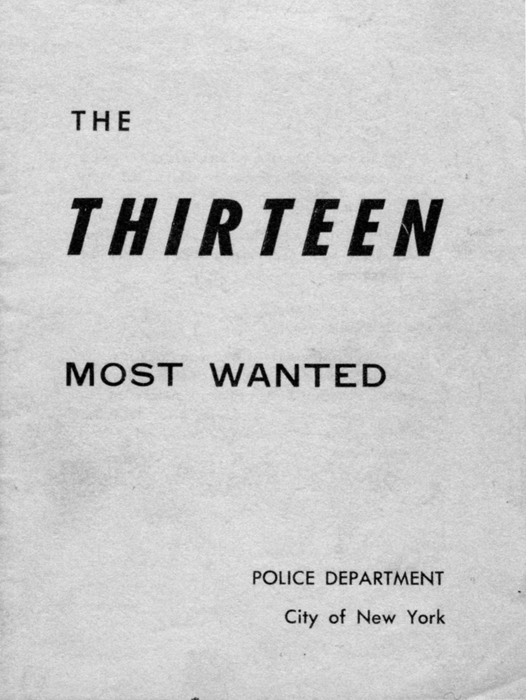
Front cover of the pamphlet of the 13 Most Wanted by the NYC Police Dept.
APRIL 27, 1964: ROBERT RAUSCHENBERG PARTICIPATES IN THE JUDSON DANCE THEATER'S CONCERT #14.
Rauschenberg danced in an untitled improvisation by Deborah Hay. Other dancers in Hay's work included LUCINDA CHILDS and Yvonne Rainer. (JD195)
APRIL 28, 1964: JUDSON DANCE THEATER'S CONCERT #15.
Included was the choreographic debut (titled Plus) of Tony Holder who would, during the summer of 1964, work for ROBERT RAUSCHENBERG, taking care of his loft and printing silkscreens for him while Rauschenberg was in Europe.
Tony Holder:
"It blew my mind to watch him (Robert Rauschenberg) work. I would arrive at ten in the morning, and he would already be drinking vodka and orange juice. And then he'd start painting, and the dog would walk across the painting, and he would erase three of the footsteps and not the others. Then he left [for Europe] and paid me to print the silkscreens on paper and then destroy the screens." (JD200)
Rauschenberg designed Holder's costume for Plus. Holder recalls that the costume "looked like a bacon, lettuce and tomato sandwich. It was green and red and white. I thought the vest looked like bread; it was a white canvas vest." (JD201)
Also on the bill was David Gordon's Silver Pieces, previously danced in Philadelphia under the name, Fragments.
David Gordon:
"We sat on the stage, watched TV, and every now and then we got up to do things. In Philadelphia, I took the TV out of the student lounge... At Judson, I took our own TV, sprayed it silver, sprayed gray leotards and tights silver, had us wear children's plastic wigs sprayed silver, and performed the dance under the name Silver Pieces. It included things like Grape Jokes, like the Empire Grape Building." (JD201-2)
APRIL 29, 1964: FRED HERKO PARTICIPATES IN JUDSON DANCE THEATER'S CONCERT #16.
Herko's dance, Villanelle, which opened the concert, was one of the sections of his full-length The Palace of the Dragon Prince performed at the Judson Chuch on May 1st and 2nd (although not under the auspices of the Judson Dance Theater). (JD202)
Carla Blank [one of the dancers in Herko's dance]:
"It was technically beyond most of us, I think. It really called for toe dancers. [Herko] had a vision that was very nineteenth century, a kind of Theater of Marvels... [Herko] always reminded me of Nureyev in his own movement. There was something about the use of the head and arms and back. It was influenced by JAMES WARING, but it was even more balletic, I think.
I remember a lot of jumps and stretched feet. Everything was very extended, high-energy, stretching everything out as much as possible. A lot of the piece was done as uison work, but I think Deborah Lee was the soloist. She had a very perfect body, very correct in terms of ballet lines. There were a lot of movements in line formations, four in a line, and I remember him running wildly through it. He didn't do much in the dance, as I recall." (JD203)
Other dances included LUCINDA CHILD'S Carnation and Deborah Hay's Three Here. Hay's piece was performed to John Cage's Williams MIx #5. (JD205)
MAY 1/2, 1964: FREDDY HERKO PRESENTS THE PALACE OF THE DRAGON PRINCE AT THE JUDSON CHURCH.
Herko's ballet (not a production of the Judson Dance Theater) was performed to music by Berlioz and St. Saens by dancers Carla Blank, FRED HERKO, Robert Holloway, Deborah Lee, Elsene Sorrentino, Sandra Neels, Phoebe Neville, Abigail Ewert and Terry Foreman. (JD208)
MAY 19, 1964: THE MADNESS OF LADY BRIGHT DIRECTED BY DENIS DEEGAN OPENS AT THE CAFFE CINO. (SB54)
DENIS DEEGAN was one of Andy Warhol's "Thirteen Most Beautiful Boys" (see January 17, 1964 above). It was Deegan who introduced Warhol to NICO in Paris in 1965 where Deegan was then living. Deegan returned to New York in 1966 where Warhol also shot him for Dentist: Nico, Ivy, Denis and Ivy and Denis 1 and II. (AD61)
The Madness of Lady Bright was written by Caffe Cino playwright Lanford Wilson. According to Stephen J. Bottoms in Playing Underground: A Critical History of the 1960s Off-Off-Broadway Movement, "Wilson's play was so significant to the Cino that its history can effectively be divided into periods 'before' and 'after' Lady Bright." (SB55)
From Playing Underground: A Critical History of the 1960s Off-Off-Broadway Movement by Stephen J. Bottoms:
"Wilson's most acclaimed and controversial Cino play was The Madness of Lady Bright... Lady Bright's portrait of an aging drag queen... slowly going mad in his own apartment, succeeds in deftly evoking sympathy and understanding for a figure taught by society to loathe himself. Based loosely on a hilariously queeny desk clerk with whom Wilson then worked at the Americana Hotel, the play is a roller-coaster monologue of emotional highs and lows... Leslie Bright constantly theatricalizes himself, conducting coversations with imaginary companions and talking to himself in his mirror: 'Mirror, you are - I am sorry to report - cracking up... I am losing my mind. I am. I am losing my faggot mind." (SB53)
MAY 19/20: FREDDY HERKO AND LUCINDA CHILDS PERFORM WITH JAMES WARING AND DANCE COMPANY AT THE JUDSON CHURCH.
In addition to Waring, Herko and Childs, dancers included Arlene Rothlein, Deborah Hay, Deborah Lee, Yvonne Rainer, Gary Gross, Toby Armour, Vincent Warren and Diana Cernovich. (JD208) (See also "Andy Warhol, Diane di Prima, Freddy Herko, The New York Poets Theatre and the Judson Dance Theatre," here.